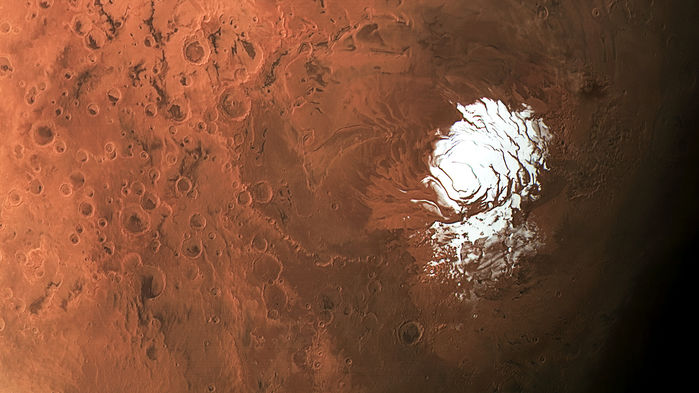Life on Mars?
July 26, 2018 | Expert Insights

A study has found liquid water sitting under a layer of ice at Mars' South Pole. This is the first time researchers have identified a stable body of liquid water on the planet.
Background
Mars is the fourth planet from the Sun and is the second smallest planet in the solar system, after Mercury. Named after the Roman god of war, it is also often described as the “Red Planet” due to its reddish appearance owing to the iron oxide prevalent on its surface. It is a terrestrial planet - that is composed primarily of silicate rocks or metals - with a thin atmosphere composed primarily of carbon dioxide.
Mars is home to the tallest mountain in the solar system, Olympus Mons, a shield volcano which is 21 km high and 600 km wide. Despite having formed billions of years ago, scientists believe that it could still be active based on recent evidence from volcanic lava flows. It has two moons, Phobos and Deimos, which are small and irregularly shaped.
For years Mars has been known to have water in the form of ice. This has led to investigations assessing the potential of habitability. In November 2016, NASA reported finding a large amount of underground ice in its Utopia Planitia region.
The first successful mission to Mars was the Mariner 4 flyby in 1965 by NASA. As of 2018, there have been 45 missions to Mars. The most recent arrivals include the European Space Agency’s ExoMars mission, comprising an orbiter, lander, and a rover which were lost on arrival. This was followed by NASA’s InSight robotic lander mission, which is now on its way and scheduled to arrive on Mars in late November this year. The Indian Space Research Organization (ISRO) had launched its first interplanetary mission in November 2013, with the Mars Orbiter Mission (MOM) – also called Mangalyaan – orbiting since September 2014.
Analysis
A recent study has found evidence that a lake, about 20 km wide with an estimated thickness of 1 m, lies under Mars’ south polar ice cap in a region called Planum Australe. Similar lake beds were present on its surface in the past. However, due to the thin atmosphere the climate has cooled, locking up most of its water in the form of ice.
"It's probably not a very large lake," said Professor Roberto Orosei from the Italian National Institute for Astrophysics, who led the study. “This really qualifies it as a body of water. A lake, not some kind of melt water filling some space between rock and ice, as happens in certain glaciers on Earth.”
The discovery was made using Marsis, a radar instrument on board the European Space Agency's (ESA) Mars Express orbiter. Such instruments examine the surface and the immediate subsurface of the planet, by sending out a signal and examining what is bounced back. Analyzing data collected between 2012 and 2015, Italian researchers spotted something unusual 1.5 km under the ice. Light blue reflections from the bottom were stronger than the surface reflection, indicating the presence of water. “We interpret this feature as a stable body of liquid water on Mars," the authors wrote in the study.
While the findings suggest that water is present, they don’t confirm much. Dr. Manish Patel from Open University explained: "We have long since known that the surface of Mars is inhospitable to life as we know it, so the search for life on Mars is now in the subsurface. We are not closer to actually detecting life, but what this finding does, is give us the location of where to look on Mars. It is like a treasure map - except in this case, there will be lots of 'X's marking the spots."
At the bottom of the ice at the Martian South Pole, the temperature is estimated to be about -68C. The water is thought to remain liquid because it is under pressure and rich in salts, particularly magnesium, calcium, and sodium compounds known as perchlorates.
The first signs of liquid water on Mars were dark stripes or stains on crater walls and cliffs seen in satellite images in 2015 by NASA, but that interpretation was questioned when researchers from the US Geological Survey argued that the mysterious dark streaks were no more than tumbling grains. Scholars will continue to search other sites on Mars for signs of more subterranean lakes or aquifers as the presence of subsurface water is not limited to a single location.
Assessment
Our assessment is that the detection of the liquid water on Mars signals very interesting prospects for scientific discoveries. We feel that the water is highly saline, which does not bode well for any life forms. However, we believe that further evidence must be pursued to test the discovery as the underground lake is not likely to be the only one on the planet.








Comments